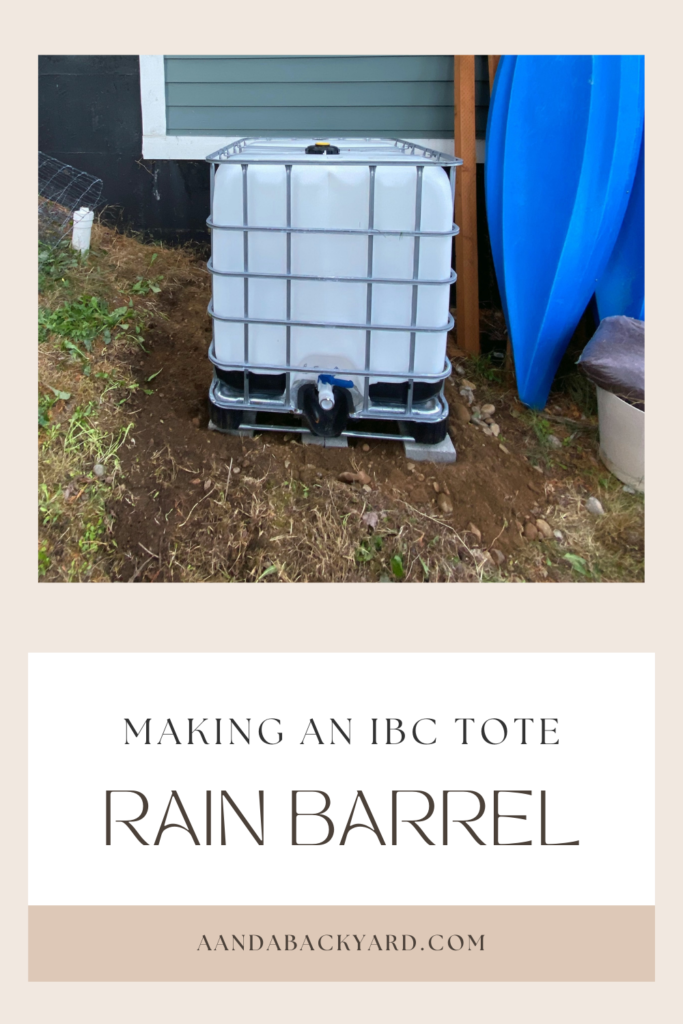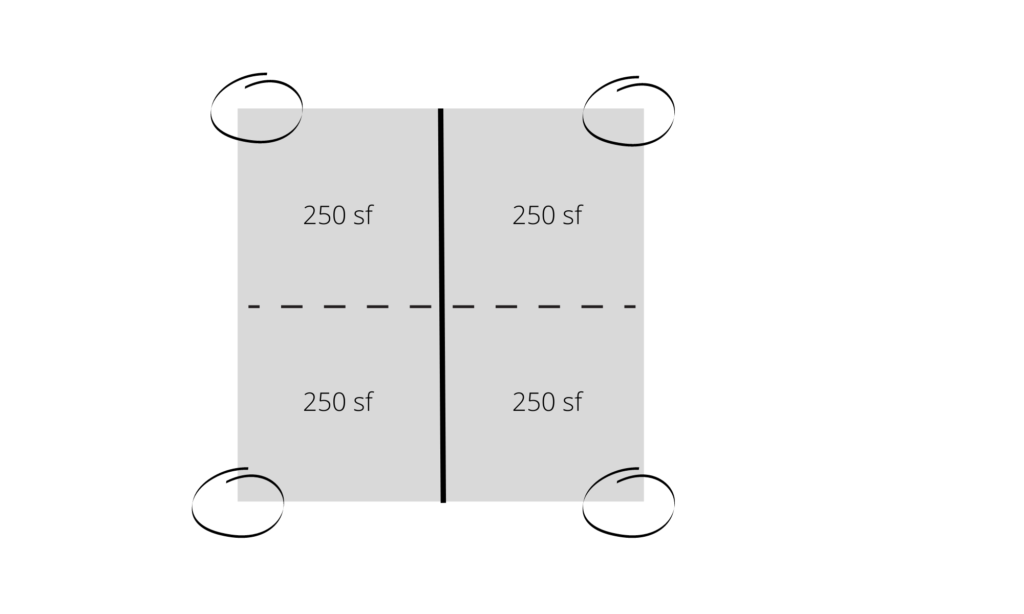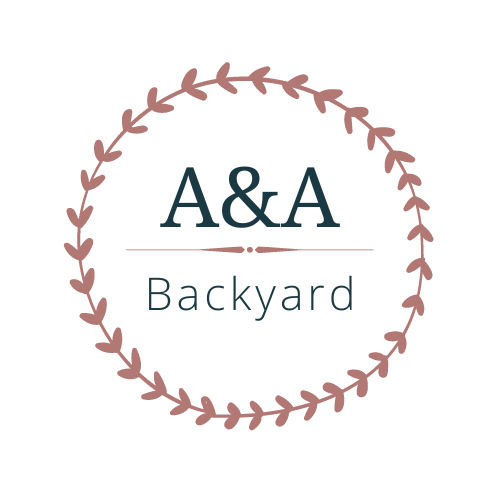This post may include affiliate links.
Even here in the Pacific Northwest, rain can be scarce, especially during the summer. Last year, in 2021, we had several record-breaking heat waves and months without significant rainfall. During that time, our garden needed plenty of water to keep our veggies and flowers producing. However, water can be expensive if you are on a public utility. A great way to save money, keep your plants green, and be more sustainable, is to install a rain barrel on your property.
In this post, I’ll give you more details about some rain barrel options and how we put installed a 250-gallon, caged, IBC tote for our rainwater collection system!

Why Should You Have a Rain Barrel?
If you live in an area that has hot, dry summers, you may not have enough rain to keep your outdoor plants happy. However, you may get more rain than you need during other parts of the year.
Here is an example of the annual precipitation we get in the Puget Sound:

In July and August, we get less than one inch per month on average, while in January and December, we average around 8″ per month. Our garden is growing the most during July and August due to the long, warm days, therefore, that’s when we need the water.
So, by installing a rain barrel to collect rainwater, we can reduce how much potable water we use from our public utility and save some money. It also helps us to be sustainable, because water that comes from the utility must be filtered, chemically treated, and pumped, which takes energy. Using rainwater from our own rain barrel uses far less energy.
The World Wildlife Organization says rain barrels also help reduce pollution saying, “Rain barrels reduce this pollution by capturing and containing rainwater, decreasing the total amount of runoff water. Less runoff means water can seep back into the ground slowly, reducing the amount of polluted water that runs into rivers and streams, which ultimately conserves bodies of water.”
How Much Water Can You Collect in a Rain Barrel?
It is very easy to calculate how much rain you can collect in your rain barrel. First, you must estimate how much roof area you have, and if you have a traditional rain gutter system, how much area each downspout serves. On our house, we have 1000 SF floor plates and a ridge line that splits our roof in half. This gives about 500 SF of area. Each corner of the house has a downspout, so each 500 SF can be split in half. So, each downspout serves 250 SF of roof area.

Next, to estimate the volume of water, you can look up how much rain you might get in a rainstorm. I like to look at my weather app, which will tell me if we will get 1″ of rain, or 8″ of rain, over the course of a storm. When you get 1″ of rain, that means if you had a flat container, the container would fill with 1″ of water.
Convert this to feet (1″ = 1/12″ ft) and multiply by the surface area. In my case, that’s 250 SF. This gives you the volume of water in cubic feet. Next, convert to gallons. One cubic foot equals about 7.4 gallons.
The equation looks like this:

In my example, a 1″ rainfall will give me 1″ x 1’/12″ x 250 SF x 7.4 = 154 gallons. For my 250 gallon IBC tote, I could fill the container with just one or two storms.
But how much does this give us? Depends on the plants. A rough estimate is that tomato plants need 1-2 inches of water per week, depending on how hot it is. But, the surface area of all my veggie gardens is less than the surface area of my roof! Worse case, if my barrel is empty in July and I can fill it with one storm, I do not have to water my plants after the storm, so I can count on my barrel to water my plants probably the rest of the month (or until the next rain).
What Other Types of Rain Barrels Are There?
My IBC tote is not the most common type of rain barrel! You may often find rain barrels in your local hardware store. Commonly, you can find 55-gallon barrel kits with the downspout connectors or diverters you need.
I like this one from Amazon because it has an attractive wine barrel design and a spigot for hooking up your garden hose:
These 55 gallon barrels are great for smaller gardens, raised beds, or container gardens. Or, if you have multiple downspouts around your house but can’t divert the gutters long distances, you could install several of these for larger storage capacity.
Of course, if you don’t or can’t buy new rain barrels, you can try to find them second-hand or used. I found my IBC tote on craigslist. I believe it may have previously been used for soda as it has a slightly sweet residual smell, even though it was cleaned before I bought it. Ebay, Craigslist, Facebook Market, and Nextdoor are great apps to use to find used gardening or homesteading equipment for cheap!
You can even use five-gallon buckets to collect smaller amounts of rainwater. My Palram by Canopia greenhouse has gutters, so I put five-gallon buckets under each end of the gutter to collect rainwater for watering plants in my greenhouse.
Installing an IBC Tote Rain Barrel
Be sure to subscribe to our Youtube Channel A&A Backyard, I have posted a video about how I installed my IBC Tote Rain Barrel.
If you prefer reading the steps, here’s what I did:
- Leveled the ground to create a pad to set my IBC Tote
- Placed concrete pavers under the corners and mid points on each side of the level pad to go under the cage supports.
- Set the IBC tote on the pavers and ensured it was level. Adjusted any of the leveling that needed to be fixed.
- Measured the distance from my downspout to the tote opening and estimated the number of fittings. I had a metal, rectangular downspout. I converted to a 3″ PVC pipe.
- Rerouted the existing downspout to the opening of the tote using 3″ PVC. I also added a “leg” to my pipe to assist with collecting debris.
- Capped the existing stormwater pipe.
- Waited for it to rain!
Here are links to some of the fittings I bought and found useful for my system:
I hope you find this post helpful. Please comment down below if you have installed a rain barrel or if you have any questions!

I want to do this, it definitely would be so beneficial to our garden. Great post!
Great post! We definitely want to do rainwater collection when we get to our forever homestead. IBC totes will likely be our collection container of choice, too! 🙂
Thank you! We have got to get going on a water collection system and now we have more information to do it!